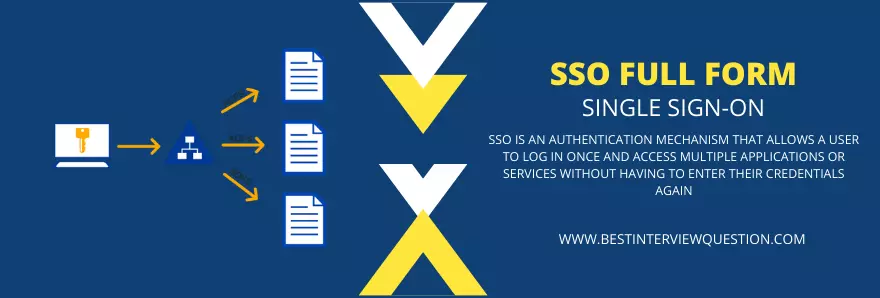What is SSO Full Form?
Single Sign-On
SSO stands for Single Sign-On, which is an authentication mechanism that allows a user to log in once and access multiple applications or services without having to enter their credentials again. With SSO, a user can authenticate once and then seamlessly access other applications or services without needing to re-enter their username and password.
SSO works by using a centralized authentication server or identity provider (IDP) that authenticates users and issues security tokens. These security tokens contain information about the user's identity and authentication status, and are used by the applications or services to grant access to the user without requiring them to log in again.
Benefits of SSO
Single Sign-On (SSO) is a technology that allows users to authenticate themselves once and access multiple applications or services without logging in again. Here are some of the most common uses of SSO:
- Improved User Experience: SSO provides a seamless and hassle-free user experience. Users can access multiple applications without remembering various usernames and passwords.
- Increased Security: SSO reduces the risk of password-based attacks, such as phishing, keylogging, and other credential-based attacks. With SSO, users do not have to remember multiple passwords, and organizations can better enforce strong password policies.
- Simplified Identity Management: SSO simplifies identity management by reducing the number of accounts and passwords IT teams need to manage. SSO provides IT teams with a centralized view of user activity, making it easier to manage user access and revoke permissions when necessary.
- Reduced Costs: SSO can help organizations reduce the cost of managing multiple accounts and passwords. With SSO, IT teams can streamline identity management and reduce the time and resources needed to manage user accounts.
- Integration with Third-party Applications: SSO can integrate with third-party applications, enabling users to access those applications with existing credentials. This provides users a seamless experience and eliminates the need for additional usernames and passwords.
There are different protocols and standards used for implementing SSO, such as SAML (Security Assertion Markup Language), OAuth (Open Authorization), and OpenID Connect. These protocols provide a framework for exchanging authentication and authorization data between the identity provider and the service provider.
SSO offers several benefits, such as improved user experience, increased security, and simplified user management for IT administrators. However, it also requires careful implementation and management to ensure that it is secure and effective.
Disadvantages of SSO
Single Sign-On (SSO) can offer numerous benefits, such as improved security, better user experience, and increased productivity. However, there are also several disadvantages that organizations should consider before implementing SSO:
- Dependency on a single point of failure: SSO relies on a central authentication server, which becomes a single point of failure. If the server goes down, all the connected applications and services become inaccessible.
- Increased risk of data breaches: If a user's SSO credentials are compromised, an attacker can access all the applications and services for which the user has permission. This can lead to a widespread data breach.
- Complexity: Implementing SSO can be complex and time-consuming, requiring significant resources and expertise.
- Compatibility issues: Some applications may not be compatible with SSO, requiring custom integrations or workarounds.
- User privacy concerns: SSO involves sharing user credentials across multiple applications and services, which raises privacy concerns among some users.
- Cost: Implementing SSO can involve high costs, such as licensing fees, hardware costs, and ongoing maintenance and support costs.
Overall, SSO can effectively improve authentication and streamline access to multiple applications and services. Still, it's essential to carefully evaluate the potential disadvantages and risks before implementing them.
